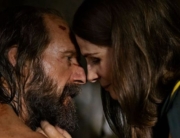

In the 1960s, director Connie Hochman studied at George Balanchine’s School of the American Ballet and later, as a dancer with the Pennsylvania Ballet, performed in many of the Russian-born choreographer’s greatest ballets. Over the years she developed a curiosity about Balanchine the teacher. What did he seek from his already skilled dancers? What was the experience of a Balanchine class like? Interviewing more than 90 former Balanchine dancers and drawing on never-before-seen archival footage of his classes and rehearsals, Hochman has created a marvelous and moving portrait of an extraordinary master at work and the dancers he influenced so profoundly.
“When Balanchine came to America, there was no real ballet training, so he had to start from scratch,” says Gloria Govrin, one of six former New York City Ballet dancers given prominent screen time. Merrill Ashley notes that Balanchine was creating “movement that was so new.” “A technique to serve that choreography had not yet been invented,” until he started his classes, according to her.
For many of Balanchine’s dancers, the classes were challenging. “It was like I was a pupil of Einstein,” comments the late Jacques d’Amboise (who died in May). Balanchine wanted speed, precision, and musicality in his dancers, and the repetitive exercises he put them through took a physical toll as several former NYCB members recall. “Your muscles would be burning.” “I remember thinking I would throw up.” “You get to a point where you think ‘I am going to fall down and die’, and he would say, ‘Dear, what are you saving it for?’”
Gradually, Balanchine’s dancers began to absorb his lessons. For Ashley, the dancing became easier. “I went from questioning to expecting to believing to being a disciple.” Heather Watts learned how to make wise and informed dance decisions on the spot. Probably the most important lesson these dancers took away was to share their knowledge with the next generation. According to Balanchine, notes Edward Villella, it is the only way this art form moves forward.
Footage shot by cinematographers Dan Lenzer, Tom Hurwitz, and Martin Morales follows Ashley, d’Amboise, Villella, Watts, Govrin, and Suki Schorer as they restage the master’s ballets and teach. But Balanchine’s star pupils worry about Balanchine being misunderstood. “What he taught in the classroom has spread around the world, with different people who didn’t actually work with him,” explains Schorer, “and so there are misconceptions about his teaching.”
While the film briefly covers some biographical details about Balanchine and the founding of the NYCB, it doesn’t address his personal life, including his marriage to Maria Tallchief or romantic obsession with ballerina Suzanne Farrell. Also notably absent (except in archival footage) is former principal dancer Peter Martins, who had been Balanchine’s personal choice to become his successor. His 30-year stewardship of the NYCB ended in 2018 after allegations of sexual assault came to light. An investigation by the company and the School of the American Ballet did not corroborate the allegations of harassment or violence.
Working with a genius like Balanchine was a once-in-a-lifetime experience, as his dancers acknowledge, and Hochman’s documentary testifies to his extraordinary gifts as a choreographer and a teacher. Dance teachers and balletomanes will also be interested in the Balanchine’s Classroom Digital Archive that the director has created to preserve the interviews and archival materials she has collected: https://inbalanchinesclassroom.com/archive/.
















Leave A Comment